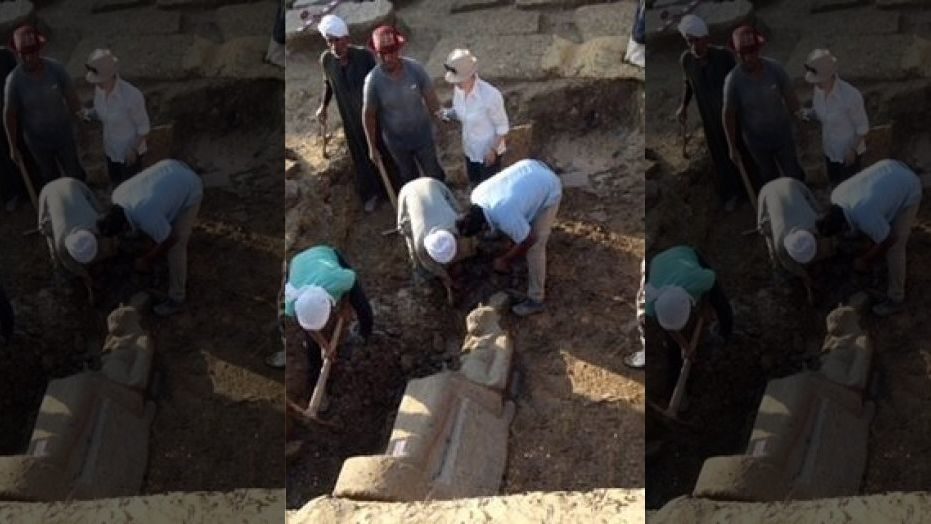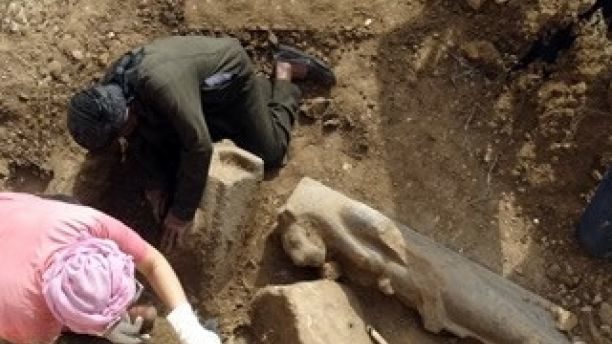A trove of black granite statues depicting the lioness goddess Sekhmet have been discovered at an ancient site in Egypt.
Researchers with the Egyptian-European Archaeological Mission unearthed the 27 fragmented statues during excavation work at the temple of Pharaoh Amenhotep III in Luxor.
In a post on Facebook, Dr. Mostafa Waziri, secretary general of the Supreme Council of Antiquities, explained that the largest of the statues is 2 meters (6.6 feet) tall. Some of the statues depict Sekhmet sitting on a throne with an ankh, or "symbol of life," in her left hand. Others show the goddess standing and holding a papyrus scepter in front of her chest. The statue's head is crowned by a symbolic sun disk and there is a uraeus, or cobra symbol, adorning the goddess' forehead.
Comment: Lion headed icons have been seen throughout history from all over the globe and often appear alongside a serpent:
- The Existence of Female Shamans: Solving the Mystery of a 35,000-Year-Old Statue
- Ancient Life-Size Lion Statues Baffle Scientists
- Archeologists Unearth Extraordinary Human Sculpture in Turkey
- Archaeologists uncover 3,000-year-old lion adorning citadel gate complex in Turkey
- The Great Sphinx of Giza reborn as a lion in the desert
Revered by the ancient Egyptians, Sekhmet is depicted with a woman's body and the head of a lioness. The goddess was associated with the sun, hence the presence of a sun disk on her statues. Sekhmet was also goddess of war, destruction, plagues and healing.
Comment: For insight on some of the happenings that those in Egypt and elsewhere may have experienced, see:
- Ten possible explanations for the 'ten plagues of Passover'
- Biblical plagues really happened say scientists
- Witches, Comets and Planetary Cataclysms
- Cosmic Winter - A Lecture by Victor Clube
- Tunguska, Psychopathy and the Sixth Extinction
- Stone carvings at Gobekli Tepe in Turkey confirm how comet struck Earth in 10,950BC
One of the statues unearthed during the Luxor excavation (Egyptian Ministry of Antiquities)
The Mission's chief, Dr. Hourig Sourouzian, said that the Luxor statues found in the upper layers of earth tend to be in better condition than the statues found in the lower layers. The statues are now being cleaned in preparation for going on display.
Some 287 Sekhmet statues have been discovered at the site since excavations began in 1998.
The finds are just the latest fascinating archaeological discovery in Egypt.
Last month archaeologists in Egypt announced the discovery of three Roman-era shipwrecks and stunning ancient artifacts on the Mediterranean seafloor off the coast of Alexandria.
Comment: See:
- Amazing pictures - Drowned city of the Caesars Baiae was Roman empire's wine-soaked party town of luxury
- Ancient Roman shipwrecks containing stunning artifacts discovered near Egyptian port
Experts also recently unearthed an ancient gymnasium that dates back to the third century B.C. A joint team of German and Egyptian archaeologists made the discovery at Watfa in Fayoum province, about 50 miles southwest of Cairo.
Earlier this month, scientists also announced that they had discovered a mysterious chamber inside Egypt's Great Pyramid of Giza.
Comment: Egyptian mysteries: Muon detection confirms giant 30-meter-long 'void' inside Great Pyramid of Giza
In September, archaeologists announced the discovery of an ancient temple belonging to King Ramses II. In August, experts revealed that they had unearthed three tombs from an ancient "great cemetery" in Egypt's Nile Valley. A month earlier, archaeologists said that a tomb that may have belonged to the wife of King Tutankhamun had been discovered in Egypt's Valley of the Kings.
In June, archaeologists from Yale and the Royal Museum of Art and History in Belgium announced the discovery of the earliest-known 'billboard-sized' hieroglyphs in the ancient city of Elkab.
Other finds include a 3,000-year-old royal tomb in the Luxor area and the tomb of an ancient gold worker on Sai Island in northern Sudan.





Comment: Also See: